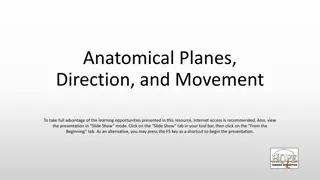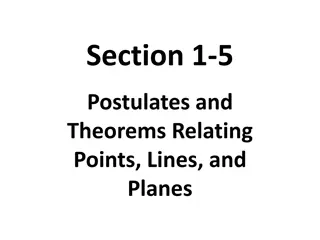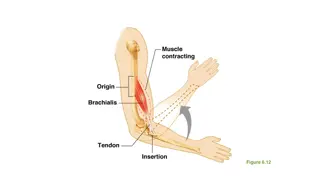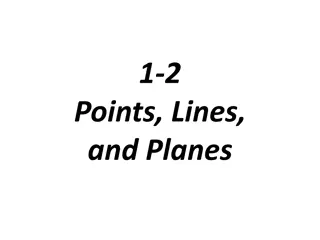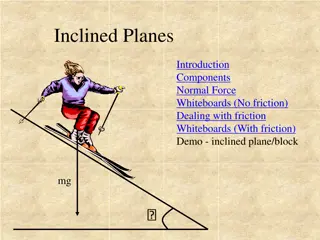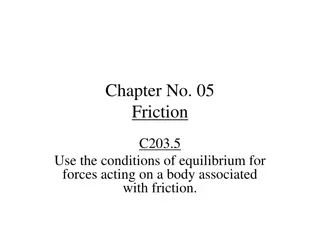Understanding Body Planes and Movements in Anatomy
Learn about the anatomical position, different body planes like sagittal and transverse, and movements associated with each plane. Explore the significance of these concepts in anatomy and how they impact the understanding of the human body's structure and function.
Download Presentation

Please find below an Image/Link to download the presentation.
The content on the website is provided AS IS for your information and personal use only. It may not be sold, licensed, or shared on other websites without obtaining consent from the author. Download presentation by click this link. If you encounter any issues during the download, it is possible that the publisher has removed the file from their server.
E N D
Presentation Transcript
Axis and Plane Dr. Subhas Chandra Nandi
Anatomical Position Anatomical position: The position with the body erect with the arms at the sides and the palms forward. The anatomical position is of importance in anatomy because it is the position of reference for anatomical nomenclature. Anatomic terms such as anterior and posterior, medial and lateral, abduction and adduction, and so on apply to the body when it is in the anatomical position. The position of reference for all movements. Also called the standing supine position
Plane A plane is an imaginary flat surface along which a movement takes place. The plane is the surface on which the movement occurs or takes place. Sagittal Plane Coronal Plane Horizontal Plane
Sagittal Plane Sagittal Sagittal plane the body into left and right sides. Flexion and extension types of movement occur in this plane, eg kicking a football, chest pass in netball, walking, jumping, squatting. plane - a vertical plane that divides A vertical plane of a body which passes from front to rear dividing the body into two symmetrical halves. A sagittal plane is an anatomical plane which divides the body into right and left parts.
Movements in sagittal plane Biceps curls Squats Walking Running Vertical jumping Climbing stairs Dorsi flexion Planter flexion Ankle Flexion Extension Hyperextension
Horizontal Plane/Transverse plane Transverse Transverse plane the body and divides the body horizontally in an upper and lower half. Rotation types of movement occur in this plane, eg hip rotation in a golf swing, twisting in a discus throw, pivoting in netball, spinning in skating. plane - passes through the middle of Any horizontal plane of a body which is parallel to diaphragm is called transverse plane or horizontal plane. The transverse plane (also called the horizontal plane, axial plane, or trans axial plane) is an imaginary plane that divides the body into superior and inferior parts. It is perpendicular to the coronal and sagittal planes.
Movement in Horizontal Plane Supination Pronation Retraction Protraction Horizontal abduction Horizontal adduction All kind of rotations.
Frontal Plane Frontal Frontal plane divides the body into the front and back. Abduction and adduction movements occur in this plane, eg jumping jack exercises, raising and lowering arms and legs sideways, cartwheel. plane - passes from side to side and Plane of the body which passes from side to side at right angles to the sagittal plane is called Frontal Plane or coronal plane. A coronal plane (also known as the frontal plane) is any vertical plane that divides the body into ventral and dorsal (belly and back ) sections.
Movements in Frontal Plane Abduction Adduction Radial deviation Ulnar deviation Side flexion of trunk Side flexion of neck Inversion Eversion
Axis The axis is the line around which the movement takes place Axis is the singular and axes are plural noun. Any movement occurs in a plane around an axis. Axis of the same plane makes and angle perpendicular to that plane.
Types Sagittal axis - passes horizontally from posterior to anterior and is formed by the intersection of the sagittal and transverse planes. Frontal axis - passes horizontally from left to right and is formed by the intersection of the frontal and transverse planes. Vertical axis - passes vertically from inferior to superior and is formed by the intersection of the sagittal and frontal planes


